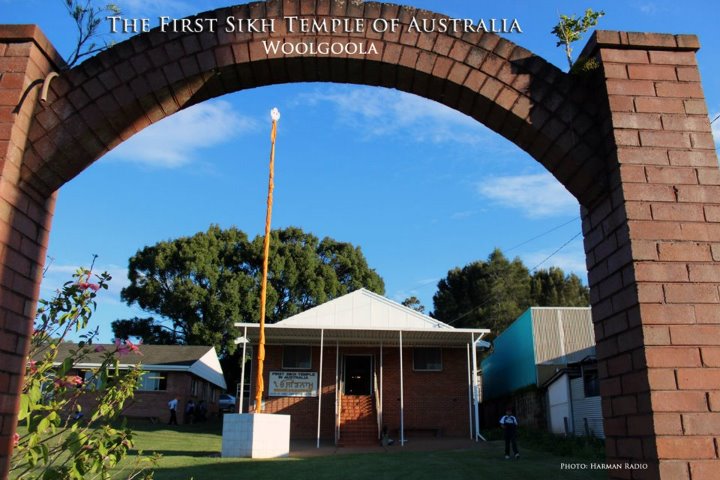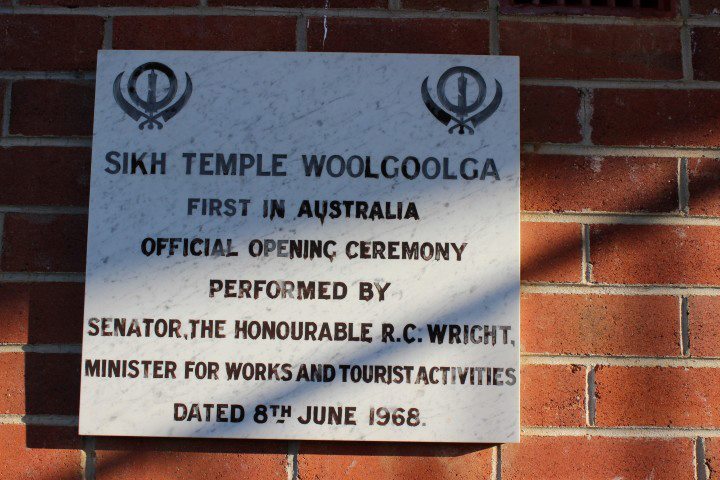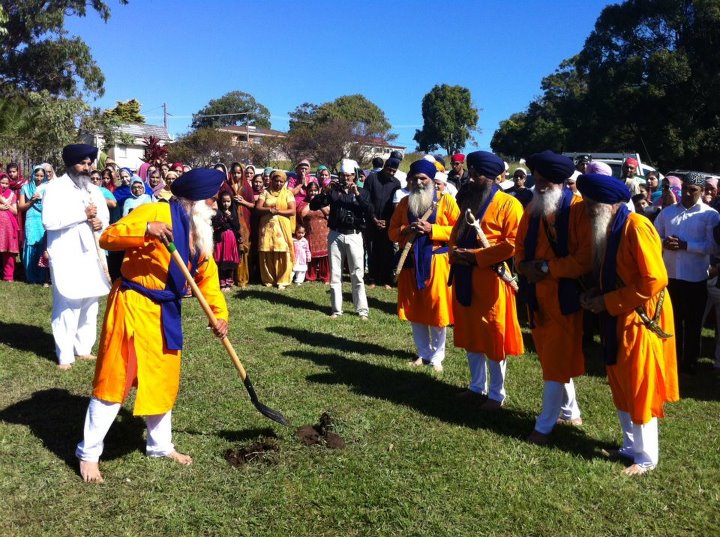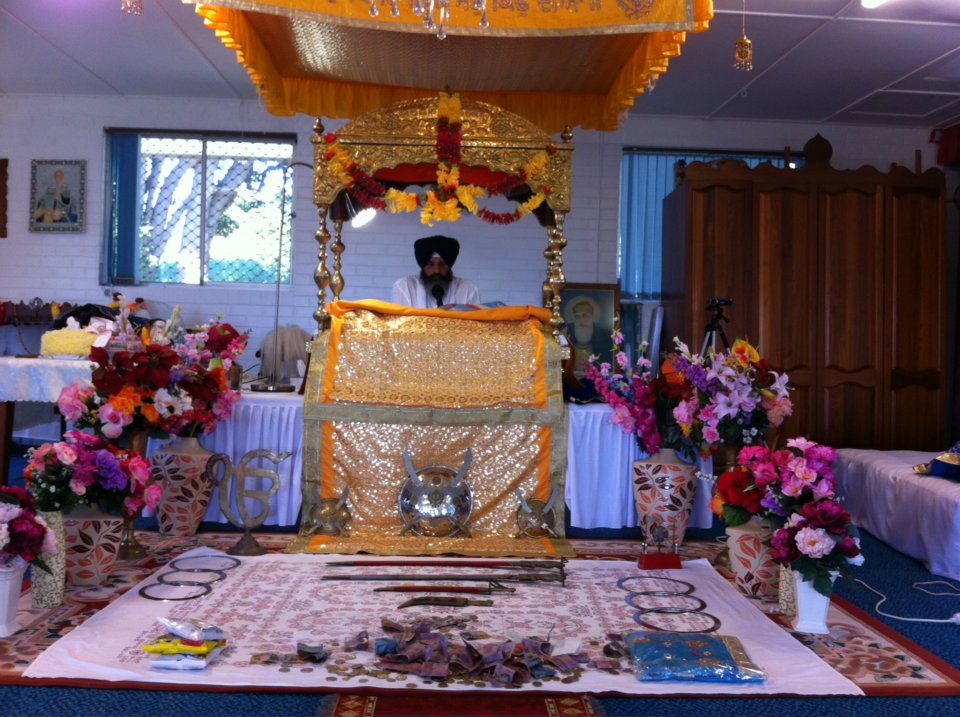The First Sikh Temple Woolgoolga
Permanent European settlement in Woolgoolga, New South Wales, Australia occurred in the 1870s. Prior to this, the area was inhabited by the Gumbaingirr Aboriginal tribe. It is believed that the name of the town derives from the word "Weelgoolga", which was used by the local Aborigines to describe the area, and the lilly-pilly trees that grew there. The name "Woogoolga" was gazetted in 1888, and changed to the current name of Woolgoolga in 1966.
Woolgoolga was an early centre of Sikh migration to Australia. Sikhs had migrated to New South Wales and Queensland prior to the imposition of the prohibition of non-European migration under the White Australia Policy in 1901 and many of them then led a marginalised life on the North Coast of New South Wales and in southeastern Queensland. Some Sikhs began to settle in Woolgoolga during World War II, because war-time labour shortages led to a relaxation of the previous prohibition of non-European labour in the banana industry. After the war they were able to acquire leasehold and freehold banana plantations. Woolgoolga has the largest regional Sikh/Punjabi population in Australia, and they are now said to own 90% of the banana farms.
Woolgoolga in New South Wales, Australia has two Gurdwaras (Sikh temples):
- The First Sikh Temple Woolgoolga (the first purpose built Gurdwara in Australia)
- The Guru Nanak Gurdwara ('The Temple on the Hill')
Sikh Migration
Early Sikh migrants came here to pre-Federation Australia as free settlers when there was no restrictive immigration policy. They were adventurist male sojoumers who left their family behind and came to make their fortune. Some of them did return, but the majority developed a love for Australia and its people and remained to lay the foundations for the Australian Sikh community.
The early Arcadian settlers came from the farming community of Punjab and settled in Northern Rivers of New South Wales and North Queensland, where they led austere and frugal lives and faced many hardships.
But for the welcome, tolerance and encouragement of Australians, establishment of Sikhs in Australia would not have been possible. There are anecdotes of the host community assisting Sikh migrants in business, financial affairs, correspondence and encouragement to maintain their culture and religion. In fact there were three members of the host community on the committee, which built the First Sikh Temple of Australia in Woolgoolga.
The descendants of those early rustic migrants have been fortunate in acquiring secondary and tertiary education in Australia. Consequently, today amongst the Sikh community we have solicitors, teachers, doctors, engineers, town planners, accountants and policemen.
Sikh migrants have integrated into the host community and have contributed to local economy. By maintaining their culture, religion and heritage Sikhs have added to the ethnic and cultural diversity of Australia, thereby helping it develop a unique and distinctive multicultural character.
Sikh Community at Woolgoolga
Locally known as the "Missing Piece of Paradise", Woopi (as it is affectionately know to the locals) is highly regarded for it's fine beaches, good surfing, varied fishing, and bush walks. Another important aspect of Woopi is it's Sikh Culture. The township's population is 50% Sikh, and they own 90% of the local banana farms. Woopi has two Gurdwara's. The Sikh Temple Woolgoolga (the first purpose built Gurdwara in Australia) and The Guru Nanak Gurdwara ('The Temple on the Hill').
The Woolgoolga community has been in existence for well over one hundred years. Prior to white settlement, the area was inhabited by the indigenous people of the Kumbaingeri tribe. It's name originated from 'Wel-gul-ga', an Aboriginal name for the local wild berry plant. Woolgoolga is a unique place where east meets west and the two complement each other and continue to thrive side by side in harmony. It has been the focus of much attention from reporters, historians, sociologists and others, for Woolgoolga is an oasis of Sikh culture in Australia.
A highway traveller approaching Woolgoolga may look in disbelief at the spectacular pure white Temple, with its golden domes reaching out to the heavens and wonder at the Indian elephant in front of a splendid palace with minarets. Is it a simmering mirage, they may wonder? These edifices have appeared to have been scooped up by magic and placed amidst an Australian town.
However, there is nothing magic about the success of the Woolgoolga Sikhs who have continued the good work in the finest tradition of the Sikh pioneers who settled here despite great hardship.
The early Sikh migrants came here to pre-Federation Australia as free settlers when there was no restrictive immigration policy. They were adventurist male sojoumers who left their family behind and came to make their fortune and returned home when they made good.
Some of these early sojourners did return, but the majority of them developed a love and attachment to this country arid its people and remained to lay the foundations for the Australian Sikh community.
The early Arcadian settlers came from the farming community of Punjab and settled in Northern Rivers of New South Wales and North Queensland, where they led austere and frugal lives and faced many hardships.
The first Sikh settlers came to Woolgooloa in the 1940s. Initially they worked as labourers on the banana plantations, but later acquired leasehold and freehold banana plantations. Sikh migrants from other parts of Australia were attracted to this area once they were aware of an established Sikh community and that good living was to be made in banana plantations. Today over 95% of Woolgoolga's banana industry and 10% of Coffs Harbour is owned and operated by Australians of Sikh ancestry.
Amongst the itinerant Sikhs who came to Woolgoolga in the 1940s were Joginder Singh, Ralla Singh, Ganda Singh and Rap Chand. The first permanent resident of Woolgoolga was Labu Singh from Belga and Booja Singh from Malpar Arkan district Jallandhar. Booja Singh was the first Sikh to purchase a banana plantation in Hollaways Road and a residence in Beach Street.
There are 2,500 Sikhs in the Coffs Harbour City Council area and 450 students enrolled at Woolgoolga Public School of whom 21% are Sikhs. At Woolgoolga High School there are a total of 877 students of whom 12% are Sikhs.
The establishment of the Sikh community would not have been possible without the welcome, tolerance and encouragement of the host community. There are anecdotes of the host community assisting the Sikh migrants in business, financial affairs, correspondence and encouragement to maintain their culture and religion. In fact there were three members of the host community on the committee which built the First Sikh Temple of Australia in Woolgoolga.
The descendants of those early rustic migrants have been fortunate in acquiring secondary and tertiary education in Australia. Consequently, today. amongst the Woolgoolga Sikh community we have solicitors, teachers, doctors, engineers, town planners, accountants and policemen.
The Sikh migrants have integrated into the host community and have contributed to the local economy. By maintaining their culture, religion and heritage they have contributed to the ethnic and cultural diversity of the town, thereby giving Woolgoolga it's unique and distinctive character. Woolgoolga truly is a microcosm of today's multicultural Australia.
We are grateful to our forefathers who chose to make their home in this country where there is personal, political, religious freedom, social and cultural equality. We are proud and honoured to be Australians. We are thankful for the privileges that we have enjoyed as Australians and we will fulfil our obligations with great enthusiasm. We will endeavour to make this community a paragon of multicultural Australia.
See also
- Australian Gurdwaras
- Sikhism in Australia
- Sikh community at Woolgoolga
- Man with the red Turban
- Turban




